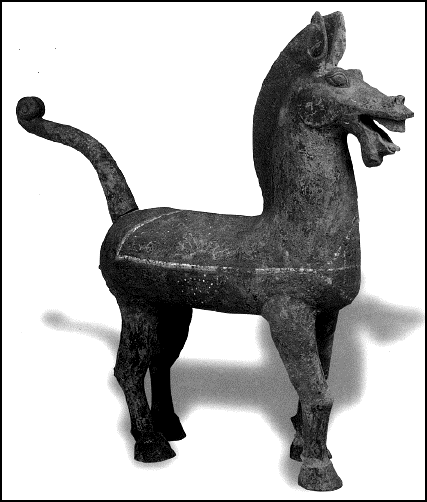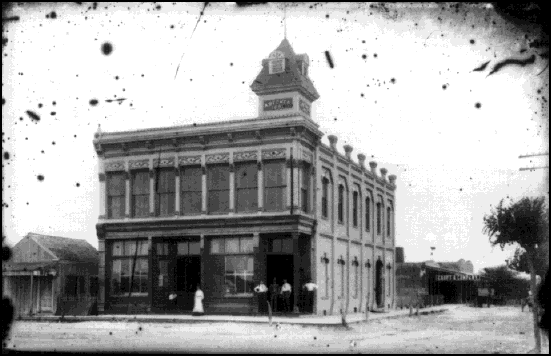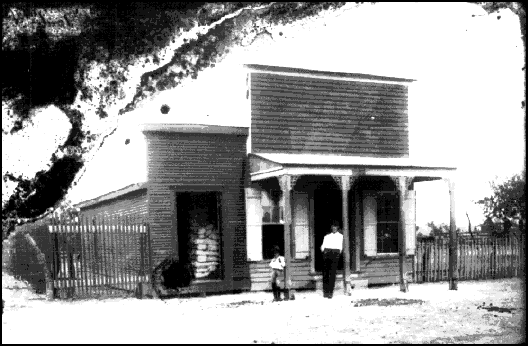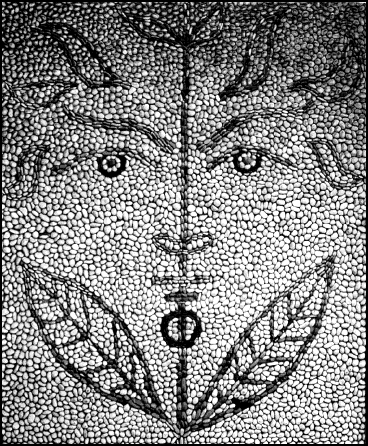
The Ceramics
Of China
5000 B.C. to 1912 A.D.
Gloria and Robert
Mascarelli
(Schiffer Publishing)

I'm guessing one would have to be somewhat deranged to take up collecting ancients ceramics of China. First off, these babies cost a small fortune. The simplest, cheapest would be your not-too-exciting "Export butterfly pattern plate and creamer" running $125 - $150. Your middle class objet d'arte might be an 18th Century "small dragon dish" ranging from $3,000 to $3,500. The heavier items include a Tang Dynasty "sancai glaze figure," a rather portly fellow, dressed fit to kill, standing atop a "glazed demon" who, despite being used as a footstool, looks not so much the worse for wear. These "lokapala" run you slightly less that a half-a million dollars.
Second problem, at least for this observer, is that most of these art pieces --- bowls, beakers, figurines, spirit jars, vases, chargers, boxes, horses, camels, pigs, camels, and spirits --- are not all that attractive. Do you want to have a "Rare Northern Qi European Warrior" on you bedtable, especially since the color is faded, the face is beastly, and the general form can best be described as "klunky?"
Each to his own taste. If for some reason you find yourself attracted to a Han Dynasty kneeling chef with cleaver and smile ($3,500 - $4, 500) or a pot-bellied "cocoon" jar from the same period ($4,000 - $5,000), this is your chance.
The volume appears to be complete, since we know nothing whatsoever about Chinese pottery except what appeals to our eye. There are extended comments on artisan histories from each of the twenty or so dynasties, including characteristics, methods of production, shapes, decorations, refinements and the later intrusion of foreign tastes.
Despite my general ho-hum feelings about most of the items here, I must say I was captivated by the drab but merry horse from the Han Dynasty [Fig. 1] and also by the glazed horse [Fig. 2] --- quite colorful (white mane, green saddle, blue hooves) with a Pepsodent smile: amused, perhaps, at those who would dare to pay $8,000 for his company.
--- R. J. KindleTurn-of-the-Century
Photographs from
San Diego, Texas
Sara R. Massey and
Ana Carolina Castillo Crimm
(University of Texas)

San Diego, Texas is not to be confused with that other San Diego off there to the west somewhere. Of the latter, we once wrote,
Some of San Diego's contributions to the universe have been the last 19th Century Governor of California, Pete Wilson, and the KGB Chicken --- who are often confused for each other --- and the annual South California Championship flea infestation: each summer the fleas return, migrating back, presumably, from the likes of Sacramento and Palm Springs, causing the locals to twitch and jump like victims of syphilitic paresis.
In the summer, San Diego holds an annual Over-the-Line Tourney with teams bearing such exotic names as "The Ted Kennedy School of Driving," "The Booger-Eatin' Morons," "Club Baby Seals," and "Roses on the piano/Tulips on the Organ." It claims to be "America's Finest City," whatever that might mean, but, in truth, it is run in the usual way by the usual poltroons to profit the disgustingly rich at the expense of the disgustingly poor.
Contrariwise, San Diego, Texas in Turn-
of- is evidently a place of some sophistication and affection for its past. The authors have brought together a hundred prints from 1898 to 1909 from the hand of amateur photographer William Hoffman.the- Century Photographs San Diego TX is in Duval County where mysterious forces won elections for both Lyndon Johnson and Jack Kennedy some years ago. The town lies some 50 miles due west of Corpus Christi. In the late 19th Century, it had a population that was 90% Mexican-American. According to some of the letters reproduced here we find that it was (and, presumably still is) hot and dusty. The main business was farming and cattle. Soldiers who lived there busied themselves with drinking, whoring, killing rattlesnakes, and --- since they cleverly built their latrines uphill from their drinking water --- battling dysentery.
William Hoffman was a journeyman photographer and left behind 350 photographs from the era. Fortunately, he was a curious young man, and took pictures of houses, businesses, ranchers, Mexican-American families and workers. The photographs reproduced here come from negatives that have been damaged by moisture, by sticking to envelopes, by melting together with other negatives, and, we suspect, by extra-terrestrials.
Thus almost every photograph shows stains, blotches, blacked out areas, weird shapes, dark stars bursting from the skies, black dragons heaving up from the ground, bubbly thunder clouds bursting over people's stores, faces, horses, and hands. A shot of Hoffman himself on page 36 shows several black stars dancing across his chest and arms with whirly white spooks playing across his pants.
A picture of two Mexican ladies on page 70 shows a large black mountain wave growing up from the lower depths to envelop them and their shack. The Bruno Rios store on page 102 pictures goods and clerks standing about obviously unaware of a glorpy monster from outer space about to descend on them from the ceiling.
The same spumous creature threatens a general store on page 109, and on page 118 it blackly envelops two-thirds of a slaughter-house with workers apparently unaware of their fate. The Methodist Church on page 175 is awash with galaxies and flying saucers both above and below ground.
A veritable twister of white-black burbling snakes descends on an innocent man and his boy on page 125 in front of their feed store, and, in one of the most fearsome, on page 183, an all-consuming hellish smoke comes bellowing up out of the horns of an innocent but obviously devil-possessed Guernsey.
In all, we are convinced that at the turn of the century San Diego Texas must have been one of the scariest venues in the whole of the Southwest, if not on earth. Thank god we weren't around there to be so spooked and instead, spend our days merely avoiding The Booger-Eatin' Morons over here to the west.

--- P. J. WirthGo to a review
of a book about
the other
San DiegoThe Complete
Pebble Mosaic
Handbook
Maggie Howarth
(Firefly)The 350 photographs here are so luscious that I immediately thought of tearing out the worn, slippery, mossy brick path that meanders up to my front door and setting in its place a stone mosaic, one with, maybe, sun and moon, flowers, interleaved with a traditional Greek god, and maybe a phoenix or two.And then I study Chapter One on "core techniques" telling me I should go out to some river or beach and get permission from the owner to pluck a few stones. I have to be sure to get the right ones (skimmers, thicks, thins), along with the right colors --- then bring them home and wash them. Then I make a drawing that I like, set up the molds and drainage gullies, being sure to have enough of the right pebbles with the right shapes.Then I set up the forms with cement and start laying the stones in them, tamping them down with the batten, grouting the joints, setting up the right mix, being sure that none of the cement stains the stones, nor that none of them stick up too high (or are tamped down too low). By the time I am done thinking of the work involved, I have to go lie down with a beer for cold comfort.So what I think I will do is, instead, when time is ripe, just go to some of the lush places shown here, to see how the artisans did it. Greece and Turkey are good for the old ones from the 13th Century. In Italy you'll find Nymphaeums --- fountains in grottos and pebblework paths (although the author tells us that some are heavily encrusted with moss.) England is big on modern community projects (check out Lytham for the bird mosaics). In fact, the author lives in Lancashire, and you might ask her to build you one just like those gorgeous blue-white spirals that she did at Gresgarth Hall.
China has some fine dragons, and, in America, there is a grotto in, of all places, Renton, Washington, a pit-stop of a town if there ever was one. Best, let's go to Menton, France [Fig. 3 below] where they hired the eccentric Marcel Cocteau to do faces and salamanders at the old fort.
Even if the construction doesn't appeal to you, The Complete Pebble Mosaic Handbook is worth it to discover just what can be done with mere stone and cement. (I apologize for not putting up the color photographs in this review. My steam-driven 1912 optical scanner refuses to produce anything other than black and white and a very disgusting puce --- like that stuff the kids put in their hair.) Despite my drab reproductions, you'll find the illustrations in the book to be colorful and inviting.
Leafing through this put me in mind of a journey I made years and years ago in my trusty rusted-out VW camper, driving all the way down the coast of Portugal from the Rio Miņo to Cape St. Vincent. The moment I crossed over from Spain, the highway turned grey and bumpy. When I got out to look at the road, I saw that it was built of granite stones, laid tightly together. For the center divider and the borders, a slightly lighter color granite had been used.
The whole thing had been laid many years ago and every single stone in it had been chipped and formed by hand. It was a great and sturdy work of art, a careful mosaic, designed to last for centuries --- one that ran the entire length of that poor and beautiful country.

--- Carlos AmanteaAt Work
The Art of
California Labor
Mark Dean Johnson
(CHS/Heyday)The California Historical Society and the Fine Arts Gallery at San Francisco State University have teamed up to mount these photographs, lithographs, paintings, statuary, drawings, posters and murals for a CHS show. A few of the names --- Thomas Hart Benton, Diego Rivera, Dorthea Lange --- will be familiar. The eighty others will be less well known.In all, there are almost a hundred of these presented in At Work, many in color --- along with essays by Joshua Paddison, Mark Dean Johnson, Tere Romo, and Tillie Olson. It's powerful stuff, and at places, it can bring sighs: sighs of pleasure for those of us who remember the time before WWII when we thought there was a chance to find support for (and home for) the real arts of the working person. At the same time, sighs of shame for some of the indignities represented here. For instance, Leonard Nadel's photograph from 1956 of Central Valley farmworkers forced to stand naked in line to be sprayed with pure DDT. (The photographer was later arrested in Mexico for documenting "bracero" recruitment.)
Much of this isn't easy. The photographs and paintings of the homeless and the workless and those on relief contrast sharply with some of the earlier romantic murals, paintings, and statues --- such as Douglas Tilden's Mechanics Memorial in San Francisco, what Paddison refers to as "romantic, gendered portrayals" from the Progressive Era. This might even apply to Diego Rivera's Allegory of California on the walls of the Pacific Stock Exchange. For appropriate contrast, there is Ester Hernández's bitter screenprint Sun Mad Raisins from 1982.For those of us who are old-time lefties, there were a couple of laughs on the CIP page. Turns out that funding for this book and the exhibit came from, among others, The William Randolph Hearst Foundation and the James Irvine Foundation. Go figure.
--- Robert J. Browder